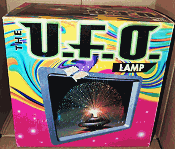Radioptics Forecast
|
|
Vintage "U.F.O." Fiber Optic Lamp In a 1963 editorial in his Radio−Electronics magazine, Hugo Gernsback dubbed electromagnetic wave frequencies above 300 GHz as "radioptics."Today, we refer to them as the sub-millimeter bands, or terahertz bands. The visual spectrum runs from around 0.63 mm (red, 630 nm, 6300 Å) to 0.36 mm (blue, 360 nm, 3600 Å). Again, Mr. Gernsback shows himself to be a prolific futurist and visionary. He was more than "all talk and no action," as he possessed many patents for his inventions and produced some build-it-yourself electronics kits. That was in addition to being a prolific writer and publisher of both fact and fiction. At the time of this article, fiber optics was a fledgling technology from a practical application standpoint. It was used in some critical communications applications due to its security advantages (difficult to tap), but in the commercial realm, those decorative multicolor fiber optic lamps were about it until laser semiconductors hit the shelf. Today, optical fiber is quickly replacing metallic conductors everywhere, most notable for Internet infrastructure. Radioptics ForecastHugo Gernsback, Editor-in-Chief ... We Are Now on the Threshold of a New Radio Era ... In our March 1962 editorial we pointed out: "Possibly the most important unexplored region in the electromagnetic spectrum lies in the band between the radio and the visible wavelengths. As we contemplate the ultraviolet, then the visible and next the infrared region, we come upon the largely unknown 'gap' of the extreme infrared or submillimeter waves which merge into the radio millimeter waves. "The gap actually extends from 1/10-mm (one-tenth of a millimeter) to 1-millimeter wavelengths. Microscopic as the gap is, it holds enormous possibilities for the future." Actually, the territory of the electronic gap is a vast, almost uncharted entity that holds many surprises for the future. Expressed in figures, 1 millimeter is 1/1000 meter (0.0394 inch), while at the other end of the gap we have 1/10 millimeter or 1/10,000 meter. Yet the shortest possible radio microwaves measure only about a millimeter. Here the radio waves merge into light waves. That is why physicists call the radio waves in this region quasi-optical waves. Why are these extremely high-frequency radio waves so important for the foreseeable future? Chiefly because they will give us more elbow room in the electromagnetic spectrum. Actually we will be vastly richer in the now overcrowded radio wavelengths, so much so that we will gain tens of thousands of new wave bands. Indeed, by the end of this century we will have millions of separate new radio frequencies that will not inter-fere with each other for these two reasons: Such extreme, quasi-optical radio waves will, in all likelihood, be coherent, just as we already have coherent optical waves. Once we have such radio waves and have solved the problem of detecting them, and, particularly, added power to their transmission, Nikola Tesla's dream of vast wireless energy at a distance will no longer be a speculation. Let us imagine only one such application - the electrical car-which surely in 50 years will replace the present-day bane, the internal-combustion automobile that now poisons our atmosphere. Overhead and short distances apart on our streets and highways, pylons with special ROF (radioptic frequency) aerials will provide our cars with electro-energy at costs not much higher than the present price of gasoline, which by that time will have been outlawed - it is to be hoped! In the communication field, the new radioptic waves will cause many radical changes. Such waves can be directed in a straight thin pencil-like beam from a parabolic transmission dish. This means that they will be more difficult to intercept than present microwave beams. Hence, also, there will be little interference with such communications unless they all take place in the identical direction. Consequently, there will be millions of separate channels, particularly if they also go out into space, toward earth satellites overhead. Radioptic waves will be particularly useful for inter-communication between earth and spacecraft, among spacecraft, between spacecraft and extraterrestrial bodies such as artificial satellites, the moon and various planets. By using power beams, it will be quite possible in the future to direct electric energy to spacecraft in transit between the earth and moon. When properly engineered, such coherent power beams will hardly spread out, hence great efficiency will be possible; the eventual transmission loss being negligible. While on earth radioptical waves cannot bend over the horizon, reasonably straight distances from earth to spacecraft should be efficient for all practical purposes. If this seems doubtful, let us consider that sunlight, which is NOT coherent, hence not efficient, comes to us over a distance of 93 million miles. True, its source is tremendous, yet the earth receives only a very small percentage of the sun's total energy. If sunlight were coherent, the earth would have been burned up billions of years ago.* Can radioptical power beams kill at a distance? This question will inevitably arise. The technical difficulties in transmitting hundreds or thousands of kilowatts efficiently over submillimeter waves, say over hundreds of miles - during this century seem insurmountable at this moment. t We have already had some success with laser power beams, but this transmission of energy beams, demonstrated by piercing metals and diamonds, took place in the laboratory, never over even a moderate distance. - H. G. * See also editorial "Millimeter Waves," June 1959 issue Radio-Electronics. † See also "Lethal Radio Waves," Radio-Electronics, August 1959.
Posted September 25, 2023 |
|

